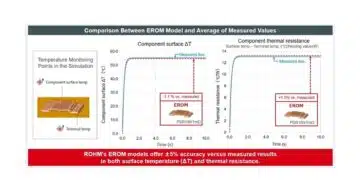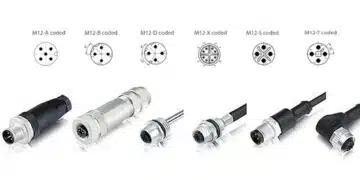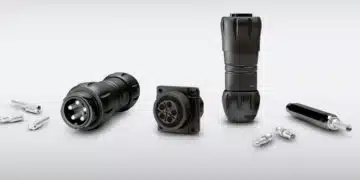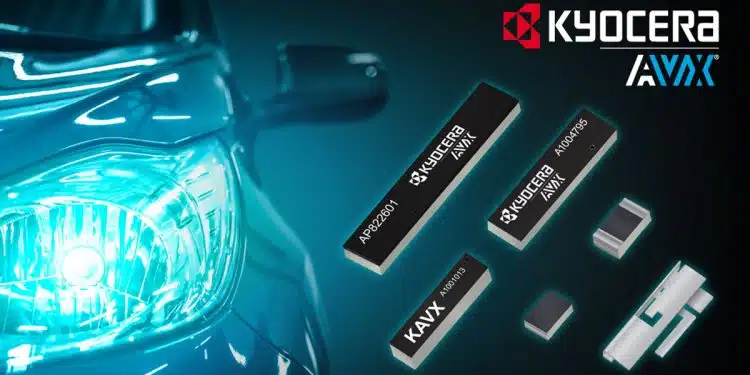KYOCERA AVX introduces new A-Series with industry’s widest range of AEC-Q200-compliant antennas for automotive applications, including wireless battery management systems, telematics control units, and vehicle access key fobs.
KYOCERA AVX, a leading global manufacturer of advanced electronic components engineered to accelerate technological innovation and build a better future, released the new A-Series low-profile, surface-mount automotive antennas.
The new A-Series low-profile SMT antennas are qualified according to AEC-Q200 standards and offer the industry’s widest range of AEC-Q200-compliant antennas for automotive applications, including wireless battery management systems, telematics control units, and vehicle access key fobs. They support a wide range of wireless technologies — including GNSS L1/L2/L5/L6, ISM, Wi-Fi 6E, Bluetooth, cellular, LTE, 5G, and UWB — and offer frequencies extending from 617MHz to 8.5GHz. The surface-mount devices are also designed to deliver superior RF field containment for improved performance in reception-critical applications and available in stamped metal, FR-4, ceramic chip, and ultra-small chip packages, all of which are RoHS compliant.
Although the automotive industry quality standard AEC-Q200 does not include antenna products, all testing for the A-Series devices has been done in accordance with AEC-Q200 procedures and requirements, including automotive-grade testing for temperature cycling, mechanical shock, and vibration. The A-Series is also available with International Material Data System (IMDS) and Production Part Approval Process (PPAP) documentation valuable to automotive manufacturers.
Some of the new A-Series antennas also feature KYOCERA AVX’s Isolated Magnetic Dipole® (IMD) technology, which allows them to deliver higher functionality and performance in smaller and thinner designs. In addition, two of those antennas (the A1001013 and A1001011) can operate both on- and off-ground. This capability is critical for heavily metallic environments, such as wireless battery management systems (wBMS), where the antenna provides wireless communication between the battery cell monitor chip and the BMS control unit.
“The new A-Series provides automotive design engineers with reliable, high-performance antennas tested in accordance with AEC-Q200 standards, and manufacturers are already taking note,” said Carmen Redondo, Director of Global Marketing for Antennas at KYOCERA AVX. “One of the A-Series antennas, the A1001013, has been selected for inclusion in Analog Devices’ (ADI) wireless battery management system (wBMS) reference design, based in part on its unique ability to operate in both off-ground and on-ground environments.”
Global semiconductor leader ADI is committed to the development of a robust information ecosystem around EV battery data. ADI’s wBMS, which is currently being deployed across multiple EV platforms, boasts ISO 21434 Cybersecurity Assurance Level Four (CAL 4) certification and is an industry benchmark for RF robustness and efficiency. So, the inclusion of KYOCERA AVX A-Series antennas is evidence of their exceptionally high quality level.
The new A-Series antennas are currently available as the following part numbers:
A1001011
• Technology: GNSS: GPS, Beidou, Galileo, Glonass
• Frequency: 1,559–1,563MHz, 1,559–1,591MHz, 1,575MHz, 1,593–1,610MHz, L1 / G1 / B1 / E1
A1001013
• Technology: ISM, BLE, Bluetooth, Wi-Fi, WLAN
• Frequency: 2,400–2,485MHz, 802.11b/g
A1000146
• Technology: BLE, Bluetooth, Wi-Fi 6E
• Frequency: 2,400–2,485MHz, 5,150–7125MHz, 802.1 a/b/g/n/ac/ax
A1004795 / A1004796
• Technology: 2G / 3G / 4G, Cellular, LTE, 5G Sub-6 GHz
• Frequency: 617–960MHz, 1,710–2,200MHz, 2,500–2,700MHz
AP822601 / AP822602
• Technology: 2G / 3G / 4G, Cellular, LTE, 5G Sub-6GHz
• Frequency: 698–960MHz, 1,710–2,700MHz, 3,300–3,800MHz
A1001312
• Technology: ISM, BLE, Bluetooth, Wi-Fi, UWB
• Frequency: 2,400–2,485MHz, 802.11 b/g, 6,000–8,500MHz
A9001978
• Technology: ISM, BLE, Bluetooth, Wi-Fi 6
• Frequency: 2,400–2,485MHz, 5,150–5,850MHz, 802.11a/b/g/n/ac/ax
A9002137
• Technology: GNSS: GPS, Beidou, Galileo, Glonass, L1/L2/L5/L6
• Frequency: 1,559–1,563MHz, 1,559–1,591MHz, 1,575MHz, 1,593–1,610MHz, 1,575.2MHz / 1,227.6MHz / 1,176.45MHz, L1 / G1 / B1 / E1, L1/L2/L5/L6
































